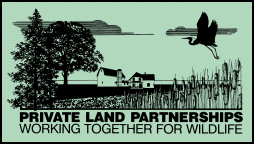 |
|
CROP FIELDS
|
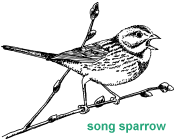 Of all the private lands in the United States, 27 percent is in cultivated cropland, which produces an enormous variety of grains, fruits, vegetables, and other products. In Michigan, about 10 1/2 million acres, or some 30 percent of the state's land base, is active farmland. In a typical harvest year an average of seven million of these acres yield nearly 25 million tons of production. Of all the private lands in the United States, 27 percent is in cultivated cropland, which produces an enormous variety of grains, fruits, vegetables, and other products. In Michigan, about 10 1/2 million acres, or some 30 percent of the state's land base, is active farmland. In a typical harvest year an average of seven million of these acres yield nearly 25 million tons of production.
Because of its size and scope, farming impacts wildlife perhaps more than any other land-use practice. The trend to fewer, larger, more intensively managed farms over the past several decades has been detrimental to many wildlife
species. Although farm crops are eaten by
deer, rabbits,
pheasants, waterfowl, and many kinds of
songbirds, many farming practices fragment good wildlife
habitat or create open habitats used by relatively few species. Increased reliance on
pesticides and herbicides, removing
fencerows to create bigger fields, fall plowing, and early and late cutting of hayfields are farming methods that negatively impact wildlife. It is difficult for farmers to make sacrifices for wildlife if the sacrifices mean reduced income. However, there are some management techniques that cost nothing or increase profits, and yet are beneficial to wildlife as well as to the landowner and community. Farmland that contains good habitat will support a broad mix of wildlife, which, in turn, will provide a continuing source of beauty, inspiration, and recreation.
Four types of habitat exist in most farmland: open cropland areas, farmstead and wooded sites, haylands, and
wetlands. Results have shown that rowcrop areas of corn and soybeans support only two or three nesting bird species and a total of only up to 88 birds per 100 acres. Pasture and haylands support seven to 11 nesting species and a total of up to 386 birds per 100 acres. Marshland supports 13 nesting bird species and up to 702 birds per 100 acres. Croplands, then, are the biggest challenge for wildlife, and this brochure offers cropland management considerations that will lessen negative impacts.
Conservation Tillage
Conventional crop production practices that include moldboard plowing and total harvesting reduce and isolate
native habitats. Unless it is plowed under, about three percent of a grain crop is left on the ground for wildlife. For example, in an area that produces 100 bushels of corn per acre, there would be three bushels available to wildlife. However, the practice of fall plowing, which is often used with conventional tillage, turns this available food resource under the ground reducing the food available to wildlife at this time of the year.
Conservation tillage is a broad term referring to several tillage methods that maintain crop residue (stubble and other plants) on the field surface. These tillage methods are intended to control
erosion, reduce compaction, conserve
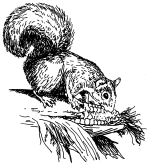 moisture, and increase
organic matter, which result in better soil conditions. Studies show that conservation-tillage fields cut production costs overall and provide yields that approach equal or exceed conventional-tillage fields. For example, one study showed that conventionally tilled compacted soil yielded only 90 bushels per acre of corn, compared to conservation tilled uncompacted soil yields of over 120 bushels per acre. moisture, and increase
organic matter, which result in better soil conditions. Studies show that conservation-tillage fields cut production costs overall and provide yields that approach equal or exceed conventional-tillage fields. For example, one study showed that conventionally tilled compacted soil yielded only 90 bushels per acre of corn, compared to conservation tilled uncompacted soil yields of over 120 bushels per acre.
The conservation approach varies from "minimum tillage," where about 20 percent of the previous year's crop residue is left, to "no till", where at least 90 percent of the previous year's crop remains on the soil surface. Although not as good as native wildlife habitat in various stages of plant
succession, conservation tillage is far superior to conventional tillage for wildlife. A Michigan study, for example, showed that fields of wheat stubble contained an average of 212 pounds per acre of weed seed on the stem in October. When not plowed, such fields provide food for wildlife all winter and the following spring. U.S. Department of Agriculature,
Natural Resources Conservation Service
(NRCS) offices have detailed guidelines on how, when, and where to plant crops using conservation tillage methods.
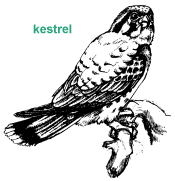 Crop Rotation Crop Rotation
Crop rotation is a time-honored farming practice that reduces plant diseases increases soil
nutrients and increase yields. When alfalfa, clover, and other
legumes are worked into the rotation, valuable nitrogen is produced, weeds are more easily controlled, compaction problems decrease, and insect food and nesting cover are increased for wildlife. It has been shown in previous studies that the highest yields of corn occurred when corn planting followed a
grass-legume meadow. In addition, plowing down first-year sweet clover produced up to 113 pounds of nitrogen per acre. Plowing down after the second year resulted in 162 pounds of nitrogen per acre.
Periodically rotating crop fields in grass or legumes also improves soil tilth, aeration and drainage--mostly because earthworms and other invertebrates are more active under sod than in row-crop cultures. An Illinois study that measured the number of breeding birds per acre in a variety of cover types found 12.0 birds per acre in mixed covers of hay, 5.6 in ungrazed grassland, 5.0 in pastures, 3.5 in red clover, 2.2 in
fallow fields and only .08 in cornfields.
Integrated Pest Management
Although conservation tillage is less harmful than conventional tillage to wildlife, it still relies on considerable chemical usage to control weeds and insects. The reduction of pesticide use can be best accomplished by crop rotation and integrated pest management. The incidence of epidemic insect damage on croplands is greatly increased when the same crop is planted on the same acreage for several years in succession. Crop rotation where no more than two
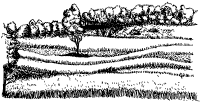 successive years of the same row crop are planted on the same acre is recommended. This will reduce plant specific insect pests below threshold levels, making the use of prevention insecticides less necessary. The monitoring and collection of adult insect pests before egg-laying time will predict potential problems. Then and only then will insecticide use be recommended. This practice not only reduces cost of crop production, it also reduces the possibility that insect pests will not become resistant to chemicals due to their continued annual use. Likewise, the soil invertebrates, which make up 90 to 95 percent of all animal species and play such a critical role in soil health, will be spared the unintentional application of pesticides into their habitats. Growers need certain kinds of insects, spiders, worms, snails, and nematodes because the invertebrates act as decomposers, pollinators, soil conditioners, food sources for higher
organisms, and control agents for other organisms which may be harmful. successive years of the same row crop are planted on the same acre is recommended. This will reduce plant specific insect pests below threshold levels, making the use of prevention insecticides less necessary. The monitoring and collection of adult insect pests before egg-laying time will predict potential problems. Then and only then will insecticide use be recommended. This practice not only reduces cost of crop production, it also reduces the possibility that insect pests will not become resistant to chemicals due to their continued annual use. Likewise, the soil invertebrates, which make up 90 to 95 percent of all animal species and play such a critical role in soil health, will be spared the unintentional application of pesticides into their habitats. Growers need certain kinds of insects, spiders, worms, snails, and nematodes because the invertebrates act as decomposers, pollinators, soil conditioners, food sources for higher
organisms, and control agents for other organisms which may be harmful.
Other Practices that Benefit Wildlife
The following are options to consider when managing your cropfields:
- Create smaller fields by strip cropping to provide narrow fields of grain next to narrow fields of forage. You can also create smaller fields by planting shrub
hedgerows and field windbreaks, which wildlife will use for food,
cover, and travel lanes.
- Establish grass or legume cover on all bare fields, even if the area is planted in another cover type the following spring. This ground cover provides soil stability and erosion control, reduces evaporation, and maintains steadier soil temperatures. Plantings of crops, shrubs, or trees that follow will grow better. Winter wheat, winter barley, and annual rye are good cover crops to consider because deer and Canada geese will graze them without decreasing crop yields the following summer. When possible, space such cover plantings with croplands to create
diversity.
- Leave a few rows of grain on field perimeters to help feed wildlife in winter.
- Preserve and restore wetlands on your property. Establish a minimum of 100 ft. of grassy nesting cover around each area of wetland.
- Establish 30-foot-wide borders of grass or legumes around the field along wooded borders to provide nesting cover, check erosion, and trap soil particles and nutrients. Keep these
buffer zones free of chemical spraying.
- Plow across slopes (contour plowing to reduce erosion, which conserves valuable topsoil and prevents sediment from washing into unfarmed areas.
- Plant native grasses and forbs along roadsides, which may be used by 40 species of birds and animals. Mow or burn these areas only before April 15 or during the month of August.
- Maintain vegetation along roads and uncultivated strips because they provide food,
shelter and travel lanes for wildlife.
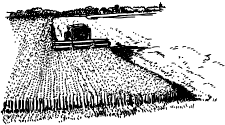 Plant food plots of corn, grain sorghum, sunflowers, soybeans or buckwheat. Protect the food plots on their north and west sides with natural habitat such as woods, wetlands or shelterbelts. If placed near wetlands or idle grasses, these food plots will greatly benefit pheasants, songbird, and
quail. If planted near woodlands, food plots will greatly benefit turkeys, deer, and squirrels. Plant food plots of corn, grain sorghum, sunflowers, soybeans or buckwheat. Protect the food plots on their north and west sides with natural habitat such as woods, wetlands or shelterbelts. If placed near wetlands or idle grasses, these food plots will greatly benefit pheasants, songbird, and
quail. If planted near woodlands, food plots will greatly benefit turkeys, deer, and squirrels.
- Plant shelterbelts around farmsteads and windbreaks around farm fields and other woody covers in odd corners and edges. Windbreaks reduce erosion and increase crop yields; shelterbelts reduce fuel costs and increase livestock production. Thick hedges or shrubby
fencerows help stop wind erosion, trap snow, and can be used as livestock fences.
Evergreens supply nest sites for doves and other birds and winter cover for a variety of wildlife. Gray and silky dogwood, highbush cranberry and hawthorn are recommended food-producing shrubs.
- Abandoned farmsteads and other old buildings or structures can be important habitat for rabbits, squirrels, raccoons, deer, woodchucks, red-tailed hawks, screech owls, barred owls, gopher snakes and garter snakes. They also attract crows, blue jays, various woodpeckers, cedar waxwings, brown thrashers, barn swallows, song sparrows, robins, catbirds, goldfinches and other songbirds. Although it might be necessary to remove some of the old structures, save any trees and shrubs and consider planting others.
- Plant field corners, rocky and low-yield fields, eroded gullies and other odd areas out of cultivation with a mixture of trees, shrubs and grasses. Do not disturb the areas by grazing, burning or mowing any more often than once every five to 10 years.
- You may wish to manage your entire farm for the greatest overall benefit to wildlife. Rather than trying to improve conditions in a certain area for one species, manage existing agricultural lands, forests and wetlands for the total picture. More habitat types and greater varieties of food and cover will result in more abundant wildlife. Involving your neighbors in a local plan will pay dividends for all.
Agricultural Odd Areas
Low-lying areas where cropped fields drain and often form eroded trenches or gullies could be planted to native
wildflowers, prairies grasses, or shrubs. Also, plant areas where natural depressions lay, usually across fields. Designed to slow water and trap soil particles and nutrients during heavy rains, these plantings also provide food to deer and geese and cover to small mammals and birds.
Plant grains or legumes on all bare fields, even if the area is planted in another cover type the following spring. This ground cover provides soil stability and erosion control, reduces evaporation, and maintains steadier soil temperatures. Legume or mixed grass-legume borders will also help to stabilize soil at field edges and provide a place to turn farm machinery. Adding buckwheat or grain sorghum to these out-of-the-way places will also provide energy food for seed eaters in fall and winter.
Field corners, rocky and low-yield fields, eroded gullies, and other odd places that cannot (and should not) be cultivated provide good wildlife habitat if planted with a mixture of trees, shrubs, and grasses or left so that plants recolonize the area -- which is less work than planting. Turn them into shelterbelts by planting alternating rows of trees and shrubs. Fruit-producing plants furnish food and cover for many species. A few rows of grain next to these grown-up odd areas increases their value during winter. Do not disturb these parcels by grazing, burning, or mowing more than once every five to 10 years, preferably treating a small segment at intervals rather than the entire piece.
In summary, there are many options available that create high producing cropfields and adequate wildlife habitat. However, remember that the poor choices you make may have detrimental effects on a variety of wildlife.
| The linked
map is an example that demonstrates the many management options
discussed throughout this chapter. The option(s) you choose should
depend not only on your goals, but the location, condition, and present
use of your land. |
Last Revised: November 28, 1999
|


 Of all the private lands in the United States, 27 percent is in cultivated cropland, which produces an enormous variety of grains, fruits, vegetables, and other products. In Michigan, about 10 1/2 million acres, or some 30 percent of the state's land base, is active farmland. In a typical harvest year an average of seven million of these acres yield nearly 25 million tons of production.
Of all the private lands in the United States, 27 percent is in cultivated cropland, which produces an enormous variety of grains, fruits, vegetables, and other products. In Michigan, about 10 1/2 million acres, or some 30 percent of the state's land base, is active farmland. In a typical harvest year an average of seven million of these acres yield nearly 25 million tons of production.